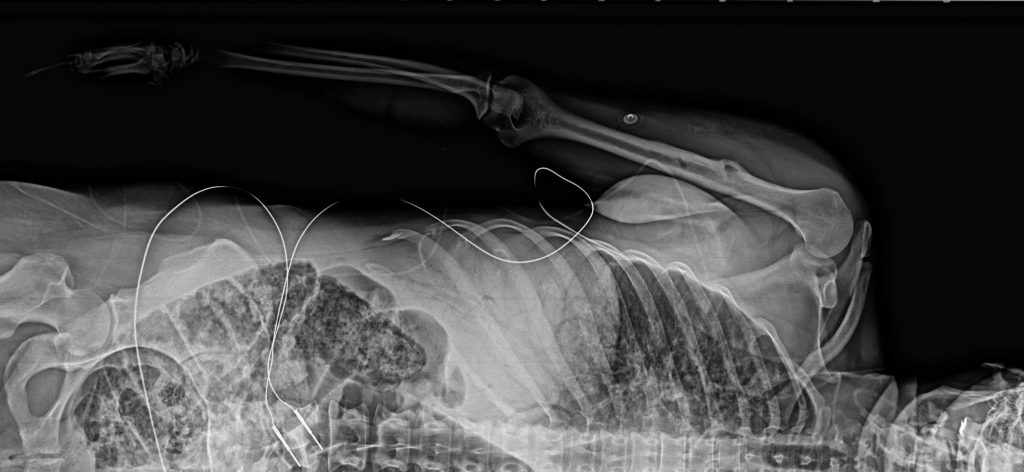This is a case of a young adult woman who was found dead at home. Her history is remarkable for drug use as well as an uncertain report of a physical attack by her boyfriend a couple of weeks ago (not reported and no medical records).
At autopsy, she had a very high postmortem level of fentanyl and no immediately life-threatening illness or trauma. But… on radiographic examination, there was an odd lesion of the right humerus. In light of the possible history of violence, I dissected the arm and got a sample of what appeared to be callus on gross exam. Here’s the pertinent portion of the radiograph:
On histologic exam, it was an expansive unencapsulated soft tissue growth within the bone:
On closer view, it consists primarily of spindle cells with some areas of more dense fibrosis:
Other areas are more loose with greater inflammation, mostly plasma cells:
At higher power, the spindle cells are plump fibroblasts with open chromatin and occasional nucleoli. The inflammatory cells are mostly plasma cells with a fair number of lymphocytes. Nothing looks atypical/dysplastic.
These findings are characteristic of an inflammatory myfibroblastic tumor, called an inflammatory pseudotumor back in the days when I was a young pathologist. While there are malignant variants, this is characteristically indolent and does not metastasize. The diagnosis characteristically is confirmed with ALK1, vimentin, and keratin expression, but since this had nothing to do with the cause of death, I made the presumptive diagnosis based on H&E and let it go.







Wonderful educational case! I like your approach to the tumor. Thank you for your summary and instructive points! Super photographs!!!
Second that. Thank you for sharing Dr. Oliver. I would suggest adding a radiologic closeup of the right humeral lesion.
If you click on the image of the radiograph, it will give you and enlarged version, I think. At least that’s what happens with my laptop.
God made this tumor. Why does God make this kind of stuff?
Well, that’s not really a pathology question, but I’ll be happy to discuss it. If you are interested, the whole theological category of “why do bad things happen to good people” is called “theodicy,” a term coined by Gottfried Leibnitz, the famous mathematician who developed calculus and philosopher who was a leading advocate of rationalism.
While there are a number of excellent discussions on this, since you asked me, I’ll give you my personal view. It is based primarily, though not entirely, on two ideas: that of cognitive closure and the necessity of consequences.
The idea of cognitive closure is that there are simply some things that we are hard wired to be unable to comprehend. It is strictly applied to consciousness,but can be generalized. Not only can we not comprehend the answer, we can’t even comprehend enough to ask the right question. Consider an ant. There is no way an ant can comprehend the mathematics behind the rotation of the earth. Moreover, the ant cannot comprehend the abstract idea of “rotation.” Moreover, the ant can’t comprehend the concept of “the earth.” So, not only is the ant structurally unable to understand the rotation of the earth around the sun, it cannot formulate the question. A mouse could comprehend more, but is in a similar situation. A dog can compehend much more, but a dog could never comprehend, say, compound interest. And again, it could never formulate a question about it.
Humans, in spite of our hubris, are similar. In fact, it’s demonstrated in child development when a child makes that surprisingly sudden leap from concrete to formal thinking (using Piaget’s operational stages nomenclature). I saw this explicitly in one of my young cousins many years ago. I was trying to help her with her homework when she was in very early elementary school. They were dealing with the idea of “less than” and “greater than.” She simply could not understand the idea in the abstract. So, I had her draw a line that was four units long and another that was six units long and asked her which line was longer. She understood that, but the abstract ideas of quantity were beyond here. Then, about four months later, it was like a window had been opened, and it was all simple for her. The same thing is true with visualization. You can visualize a one dimentional object — a dot. You can visualize a two dimensional object — a line. You can visualize a three-dimensional object — a cube. But you are biologically unable to visualize a four dimensional object. You can abstractly think of one, but you cannot “see” it in your mind.
There are simply some things that we, as human beings with organic brains, are *hard wired* to be unable to understand. This leads to a profound paradox among naive materialists and atheists. They seem to believe that humans are just animals like any other — but humans are unique in that they are not limited by cognitive closure like all other animals are. If they can’t “see” it, they don’t believe it, and they don’t believe there is anything beyond their comprehension.
It’s just not true. Recognition of this in the realm of consciousness has led to so-called “new mysterianism.”
It is also the point of the story of Job. If you read the book of Job in the Bible, you see a man who is faithful to God, but whose life is destroyed by Him on the basis of a glorified bar bet. The book consists of a number of “friends” of Job who come and give him various rational reasons for his tribulations. Then, at the end, God comes and answers him. God’s answer is pretty much “You are not competent to understand what I do, or even ask the right question. I’m God. You’re not. Suck it up, Buttercup.” Or, in His words:
“Who is this that questions my wisdom with such ignorant words? Brace yourself like a man, because I have some questions for you, and you must answer them.
“Where were you when I laid the foundations of the earth? Tell me, if you know so much. Who determined its dimensions and stretched out the surveying line? What supports its foundations, and who laid its cornerstone ss the morning stars sang together and all the angels shouted for joy?”
God goes on for some time, with such things as:
“Will you discredit my justice and condemn me just to prove you are right? Are you as strong as God? Can you thunder with a voice like his? All right, put on your glory and splendor, your honor and majesty. Give vent to your anger. Let it overflow against the proud. Humiliate the proud with a glance; walk on the wicked where they stand. Bury them in the dust. Imprison them in the world of the dead.
Then even I would praise you, for your own strength would save you.”
(from Job, chapters 38-40)
The bottom line for this argument is thus, not only can you not handle the truth, you can’t comprehend it or even ask the right question.
The second leg of my position rests on the idea that it is impossible to have order without consequences. Every physical law that allows life *also* carries with it negative consequences. You can’t have gravity without having the risk of falling and breaking a leg. Should God not have created gravity? Perhaps not. But without gravity, you can’t have the universe. Saying “Why does God allow tumors” is a little like saying “Why does God allow people to get hurt when they fall out of a building?” Gravity is not “good” or “bad.” It simply is. The physical processes that result in tumors are not “good” or “bad,” they simply are, and they are *necessary* for the existence of the universe. Moreover, my personal belief is that it is impossible to create a universe independent from the direct intervention of God in every single movement of every single subatomic particle without such consequences. It is thus impossible to have this universe without such things. God could, and perhaps has, created universes with different laws — and they would have their own consequences so that that were there people in them (however constructed), they would be asking the same question.
Of course, a world where God did tweak every movement of every subatomic particle to make sure there were no consequences of either physics or personal decisions, there would be no such thing as humans as independent thinkers, however limited. There would only be automatons. Thus, tumors such as this represent the necessary cost of you being human and able to ask the question you asked.
So, the reason this tumor can arise is so you can ask why God let the tumor arise, even though it’s the wrong question and you couldn’t understand the answer to the the right question even if could figure out what the right question was. Which you can’t.